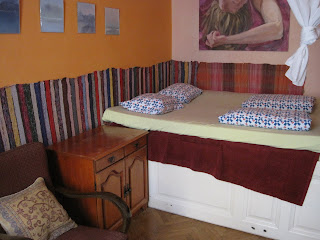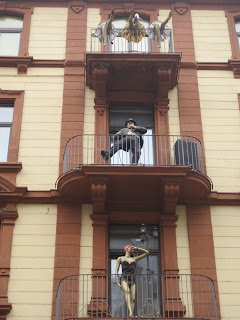
How does one describe a visit to Auschwitz? A journey to the gates of hell perhaps? A place of unimaginable suffering and brutality? Probably all are insufficent. Yesterday we spent the day visiting Auschwitz and the nearby camp of Birkenau (Auschwitz 2). It's a little over an hour by bus from Krakow. We travelled in this strange mini-van, posing as a municipal bus, which picked up people along the route so that by the time we reached the little town of Oswiecim (renamed Auschwitz by the Nazis. Incredibly, the town now bares the inscription, Oswiecim: city of peace) it was packed to capacity and stifling hot. It was a pretty unpleasant ride, (despite the very pretty Polish countryside we passed), but it did make me think of all these people crammed into those windowless cattle cars and though nothing at all like the horror of those cramped conditions, it felt quite appropriate to not be comfortable.

The two camps are joined by a free bus service. We first went to Birkenau. Beyond the famous main entrance and watch tower, through which the trains passed, the most overwhelming thing is the sheer size. It's enormous. At its peak there were 100,000 people living here under the most appalling conditions. Each of the barracks housed as many as 1,000 people. We listened to a guide tell a tour group that the prisoners were only allowed to go to the toilet twice a day and because there were so many, they only had about 40 seconds to use the latrine. Just one of many awful stories.
A lot of the barracks are still standing (where they are not, you can see the foundations so it is easy to get a sense of the scale). At the far end of the camp, at the end of the railway line, are the remains of the gas chambers and crematoria. They were blown up by the Nazis just before the camp was liberated. Despite the heaps of rubble you can see the steps down which prisoners were led, the changing room where they were forced to strip before being led into the "showers".

Auschwitz main camp houses the museum in the brick barracks (it was formerly Polish army barracks) where prisoners were held. Unlike Dachau, where the museum assaulted you with information, here it is relatively succint, leaving you to take in the exhibits. One of the barracks contains huge displays of what was taken from those before they were gassed: mountains of hair shaved off prisoners (the Nazis sold the hair to textile firms), spectacles, shoes, tooth brushes, and artificial limbs. There are piles and piles of these things, and this probably just a fraction of what was found.
The walls of the barracks were lined with photos of prisoners admitted to Auschwitz including their date of arrival and death. Some lived only a few days, some a few months and some more than a year or two. How to survive such a hell hole for a day let alone a year, I just cannot fathom.
It turned out to be a very sunny day. There were purple and yellow flowers growing among the grass and shady trees that offered respite. But the overwhelming sensation for me was incomprehension, sadness and anger. Though as many of you may know I am not a practicing Jew, I did feel a strong connection with all those who were lost.
At one point I found myself humming the tunes of Jewish songs we sang at King David High School, songs that I had forgotten or buried deep in my memory. Then I remembered we had a school teacher, Dr Yageel, who was a holocaust survivor from Auschwitz and had a tattoo on his shoulder bearing his prisoner number. I remember him to be a short man, with a beard and a lined face. I think he may have taught our class on a few occasions. I never really thought about what he went through or took the time to chat to him. I recall thinking of him as a survivor as if he were an ex-football player or someone who had climbed a mountain. What I mean is, I don't recall me or anyone else at school for that matter paying him the kind of respect he deserved. I wish now I could shake his hand.
 Yesterday we did a walking tour of "Jewish Krakow" which was mainly focused on the Jewish quarter (Kazimierz). Our guide told us that before the war there were something like 70,000 jews in Krakow, a community dating back to the 14th century. Now there are just 97 left.
Yesterday we did a walking tour of "Jewish Krakow" which was mainly focused on the Jewish quarter (Kazimierz). Our guide told us that before the war there were something like 70,000 jews in Krakow, a community dating back to the 14th century. Now there are just 97 left.


















































